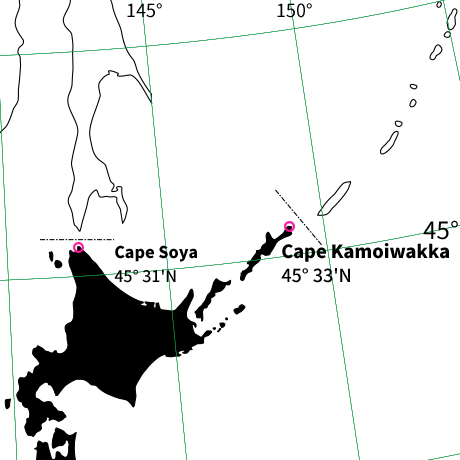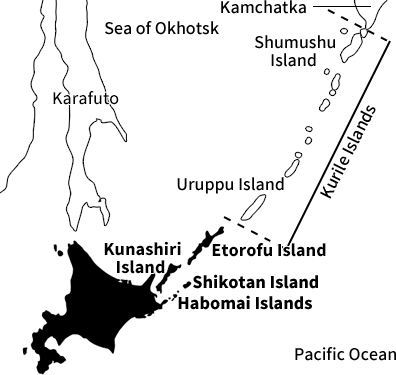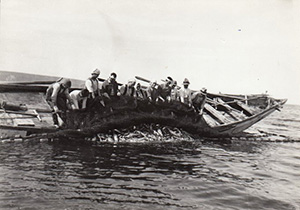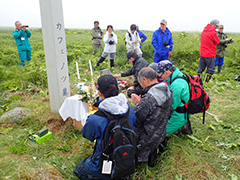Three-minute lecture on the Northern Territories issue
1. The Northern Territories are four islands northeast of Hokkaido.
The Habomai Islands, Shikotan Island, Kunashiri Island, and Etorofu Island northeast of Hokkaido are referred to as “the Northern Territories” or “the four northern islands.” The island closest to Cape Nosappu on the Nemuro Peninsula is Kaigara Island, which is one of the Habomai Islands and is only 3.7 km from Hokkaido. After the war, the four northern islands were occupied by the Soviet Union without legal grounds, and since then, Japanese people have not been able to visit the islands freely even though they are Japanese territory.

2. Japan's northernmost tip is on Etorofu Island, the largest island in Japan other than the four main islands.
The northernmost point of Japan is Cape Kamoiwakka (45°33'N), the northernmost tip of Etorofu Island. Etorofu Island is the largest island in Japan other than the four main islands, measuring 204 km in length. Cape Soya in Wakkanai (45°31'N) is the northernmost point of the main island of Hokkaido, but not of Japan.

3.
The area of the Northern Territories
They are roughly the
size of Fukuoka Prefecture.
The Northern Territories measure approximately 5,000 km2, making them as large as Fukuoka Prefecture or Chiba Prefecture. Kunashiri Island is larger than Okinawa Island, and Shikotan Island is larger than Dogo Island in the Oki Islands.


4. The Northern Territories had never been held by another country.
On February 7, 1855, Japan and Russia peacefully and amicably signed the Treaty of Commerce, Navigation and Delimitation between Japan and Russia (the Treaty of Shimoda), confirming the natural border between the islands of Etorofu and Uruppu at that time. The Northern Territories are inherent parts of Japanese territory that had never been held by a foreign country.

5. The Northern Territories are islands developed by Japanese people with difficulty.
The Northern Territories were already related to Japan in the early 17th century, and were developed by Japanese people as islands directly controlled by the Edo shogunate from the end of the 18th century onward. Japanese people opened fishing grounds and sea routes, cut wood, and operated mines, ranches, and fishery processing plants. The four northern islands were places where many Japanese lived and whose land Japanese people inherited.

. Soviet troops invaded the four northern islands in 1945, and Russia has continued to occupy these islands.
The Soviet Union joined the war against Japan on August 9, 1945, in violation of the then-effective Neutrality Pact between the Soviet Union and Japan, and occupied all four northern islands between August 28 and September 5, 1945, after Japan accepted the Potsdam Declaration. The islands have been occupied by Russia to date without any legal grounds.

7. A total of 17,291 islanders were expelled.
Approximately half of the 17,291 Japanese who lived on the four islands at that time escaped on their own, and the rest of the islanders were forcibly expelled by the Soviet Union, detained on Sakhalin (then Karafuto), and then returned to Japan. Currently, no Japanese live on the four islands.

8. The continuous Russian occupation has no legal grounds.
It is clear that the Russian occupation of the Northern Territories is not grounded in historical fact or international law.
- (1)
- The Northern Territories had never been held by a foreign country.
- The Northern Territories are inherent parts of Japanese territory that had never been held by a foreign country after the border was drawn between the islands of Etorofu and Uruppu in the 1855 Treaty of Commerce, Navigation and Delimitation between Japan and Russia. Japan did not acquire the islands by war. It was determined by peaceful arrangement that they belong to Japan.
- (2)
- Russian occupation violates the principle of no territorial expansion
- The Allies declared the principle of no territorial expansion as a policy after the Second World War, and this principle was carried over to the Potsdam Declaration. Accordingly, they had no right to ask Japan to abandon the Northern Territories, which are inherent parts of Japanese territory, and there was no international agreement with such legal effect.
- (3)
- The Northern Territories are not included in the Kurile Islands.
- Japan waived its territorial rights to the Kurile Islands under the San Francisco Peace Treaty, but the Northern Territories, which are inherent parts of Japanese territory, are not part of the Kurile Islands. Not only does the Treaty for the Exchange of Sakhalin for the Kurile Islands define certain terms, but the US government officially clarified these terms (Memorandum of Understanding on the Negotiations between Japan and the Soviet Union dated September 7, 1956).
9 Japan promotes peaceful negotiations and mutual understanding.
The Government of Japan has tenaciously continued negotiations with
Russia under the policy of resolving the issue of the Northern
Territories, which are inherent parts of Japanese territory, and
concluding a peace treaty with Russia.
To deepen mutual understanding between the Russian and Japanese peoples
toward the resolution of this issue, the government promotes mutual visits
and exchanges, including visits to northern graves, exchanges with the
four islands, free visits by former islanders and their families, and
humanitarian assistance.


10. Reclaiming the Northern Territories by the power of each citizen
The Campaign for the Return of the Northern Territories began in
Nemuro shortly after the four northern islands were occupied by the
Soviet Union, and it spread throughout the country. Councils for the
irredentist movement have been established in all prefectures and
have continued to engage in activities.
For the realization of the return of the Northern Territories, it is
important for each and every citizen of the country to understand the
issue, take interest in it, and work together.
